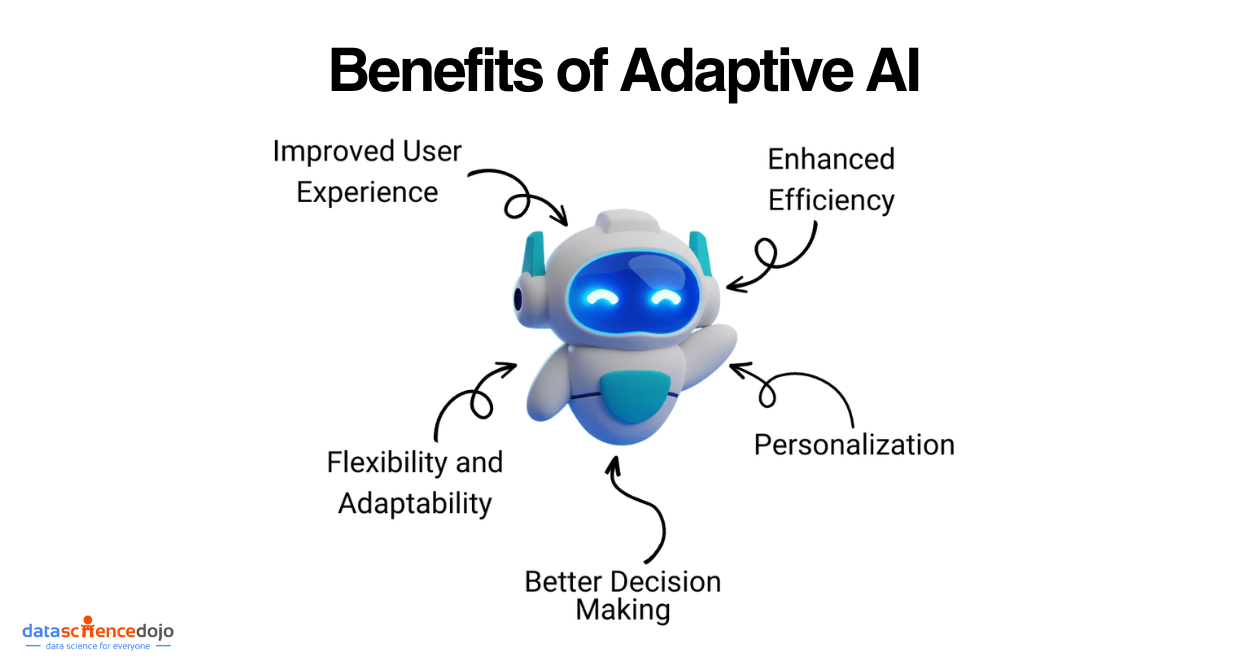Adaptive AI has risen as a transformational technological concept over the years, leading Gartner to name it as a top strategic tech trend for 2023. It is a step ahead within the realm of artificial intelligence (AI).
Learn how to use custom vision AI and Power BI to build a bird recognition app
As the use of AI has expanded into various arenas of the world, the technology has also developed over time. It has led to enhanced use of AI in various real-world applications. In this blog, we will focus on one aspect of AI that has been developed, called adaptive AI.
Explore how AI is helping webmasters and content creators progress in 4 new ways
We will explore the basics of adaptive AI, its major characteristics, key components, and prominent use cases within the industry. As we explore this new dimension of AI, we will also navigate through the reasons that make this technology a need for modern-day businesses.
Let’s dig deeper into the world of adaptive AI and its influence on today’s business world.
What is Adaptive AI?
It is a form of AI that learns, adapts, and improves as it encounters changes, both in data and the environment. Unlike traditional AI, which follows set rules and algorithms and tends to fall apart when faced with obstacles, adaptive AI systems can modify their behavior based on their experiences.
Understand AI-powered document search
This enables adaptive AI to deliver enhanced results through continuous adjustments of its code without the need for human input or guidance. Thus, it provides a higher level of adaptability that cannot be achieved through the implementation of traditional AI.
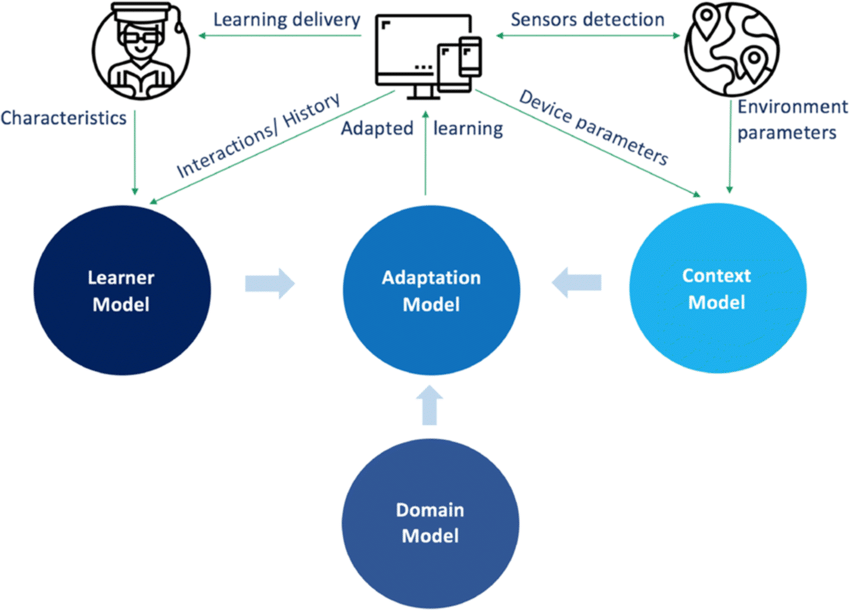
This technological advancement in AI holds immense importance. Its many benefits make it a critical tool for use across various industries. Some key benefits of adaptive AI include:
Enhanced Efficiency
It improves operational efficiency by picking up on patterns and predicting outcomes. Hence, reducing mistakes and speeding up decision-making processes. This results in tasks being completed quicker and with fewer errors without needing constant human oversight.
Personalization
It can analyze user habits and preferences to provide personalized recommendations, whether for shopping, content, or services. This not only enhances user satisfaction but also increases customer retention by delivering experiences tailored to individual preferences.
Read further about AI-driven Personalization
Improved User Experience
By understanding and anticipating user needs, adaptive AI can provide a more streamlined experience. It can offer relevant suggestions and recommendations based on user behavior and preferences, making interactions more engaging and effective.
Better Decision Making
Valuable insights into user behavior and preferences with adaptive AI can inform strategic decision-making. By analyzing data, it can identify trends and patterns that optimize business operations and guide the development of more effective strategies.
Flexibility and Adaptability
These advanced AI systems are designed to adjust their algorithms and decision-making processes when they encounter changes in input data or operational contexts. This flexibility makes them practical and relevant even in dynamic and unpredictable situations.
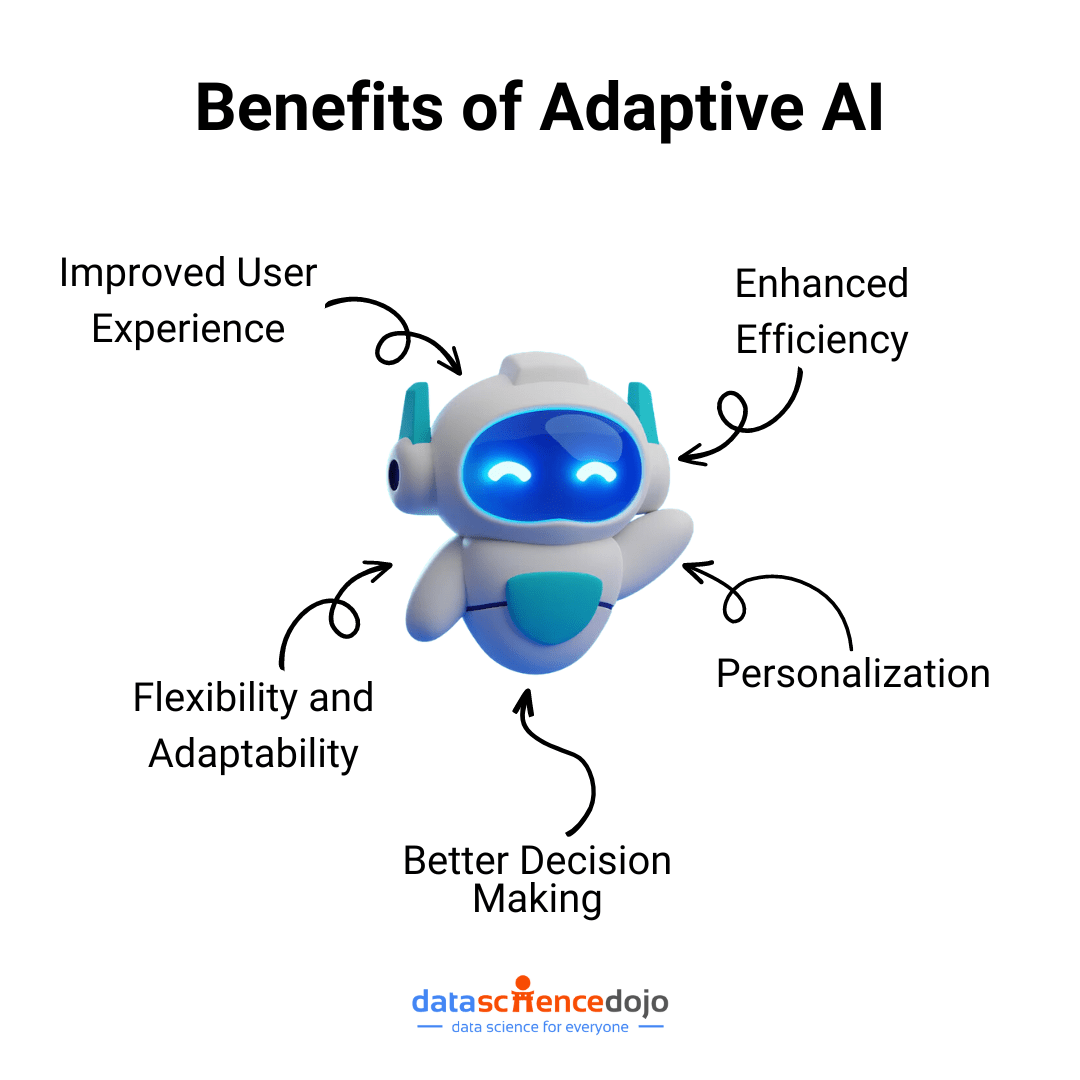
With all these advantages to offer, adaptive AI promises continuous improvement for businesses, enabling them to optimize their operational and analytical practices.
What are the Key Characteristics of Adaptive AI?
Since adaptive AI has emerged as a new and advanced branch of artificial intelligence, it is important to understand the basic qualities that make it stand out. Some key characteristics that make AI adaptive are:
Ability to Learn Continuously
The AI system can process and analyze new information. By leveraging machine learning algorithms, it is able to acquire knowledge, identify patterns, and make predictions based on the data it ingests. Since the system relies of input information to adapt, it presents the ability to learn continuously.
Adaptability
These AI systems can adjust their algorithms and decision-making processes when they encounter changes in input data or the context in which they operate. This flexibility ensures they remain practical and relevant even in dynamic and unpredictable situations.
Self-Improvement
These systems possess the ability to self-monitor and improve over time. By analyzing their performance, identifying weak or inefficient areas, and refining their algorithms in response, adaptive AI systems continuously enhance their capabilities.
Problem-Solving Capabilities
It develops sophisticated approaches to problems by learning from experience and adapting to new information. This often leads to more innovative solutions, surpassing the capabilities of traditional AI systems.
Explainability and Transparency
The AI systems prioritize explainability and transparency, allowing users to understand how the AI arrives at its decisions. This feature builds trust and ensures ethical and responsible development of the technology.
By combining these characteristics, adaptive AI systems are well-equipped to handle ever-changing environments, making them suitable for a wide range of real-world applications. Before we explore its many applications, let’s understand how to implement adaptive AI in any business.
How to Implement Adaptive AI in a Business?
Major Components Involved in the Implementation Process
Before we understand the roadmap for the implementation of adaptive AI, let’s explore the key components involved in the process.
- Machine Learning Algorithms:
- These algorithms allow AI systems to learn from data and make predictions or decisions based on their learning. Machine learning is categorized into three main types:
- Supervised Learning: This is where the system receives labeled data and learns to map input data to known outputs.
- Unsupervised Learning: The system learns patterns and structures in unlabeled data, often identifying hidden relationships or clustering similar data points.
- Reinforcement Learning: Through trial and error, the system adjusts its actions based on feedback in the form of rewards or penalties.
- These algorithms allow AI systems to learn from data and make predictions or decisions based on their learning. Machine learning is categorized into three main types:
- Neural Networks and Deep Learning:
- Neural networks are inspired by the structure of the human brain, consisting of interconnected layers of nodes or neurons. Deep learning involves using large neural networks with multiple layers to learn complex patterns and representations in data.
- Transfer Learning and Meta-Learning:
- Transfer Learning: AI systems leverage the knowledge learned from one task or domain and apply it to another related one. This significantly reduces the required training to speed up the learning process.
- Meta-Learning: Sometimes called “learning to learn,” meta-learning trains AI systems to optimize their learning algorithms, improving their ability to learn new tasks or adapt to changing environments.
- Evolutionary Algorithms:
- These algorithms use principles of natural selection and involve optimization through successive generations of candidate solutions. Adaptive AI uses evolutionary algorithms to optimize AI models, select features, and tune hyperparameters, enhancing the system’s adaptability and performance.
- Continuous Learning Mechanisms:
- Adaptive AI systems do not get stuck in the past. They actively seek new information and update their knowledge base in real-time. Common methods include:
- Online Learning: Updates the model based on each new data point, allowing immediate adaptation to changing circumstances.
- Transfer Learning: Applies knowledge gained from one task to another, accelerating learning and improving performance on similar problems.
- Active Learning: Selects the most informative data points to query, making the learning process more efficient and targeted.
- Adaptive AI systems do not get stuck in the past. They actively seek new information and update their knowledge base in real-time. Common methods include:
The 7-Step Implementation Process
The implementation process of adaptive AI in business involves a series of structured steps to ensure the system aligns with business objectives and operates effectively.
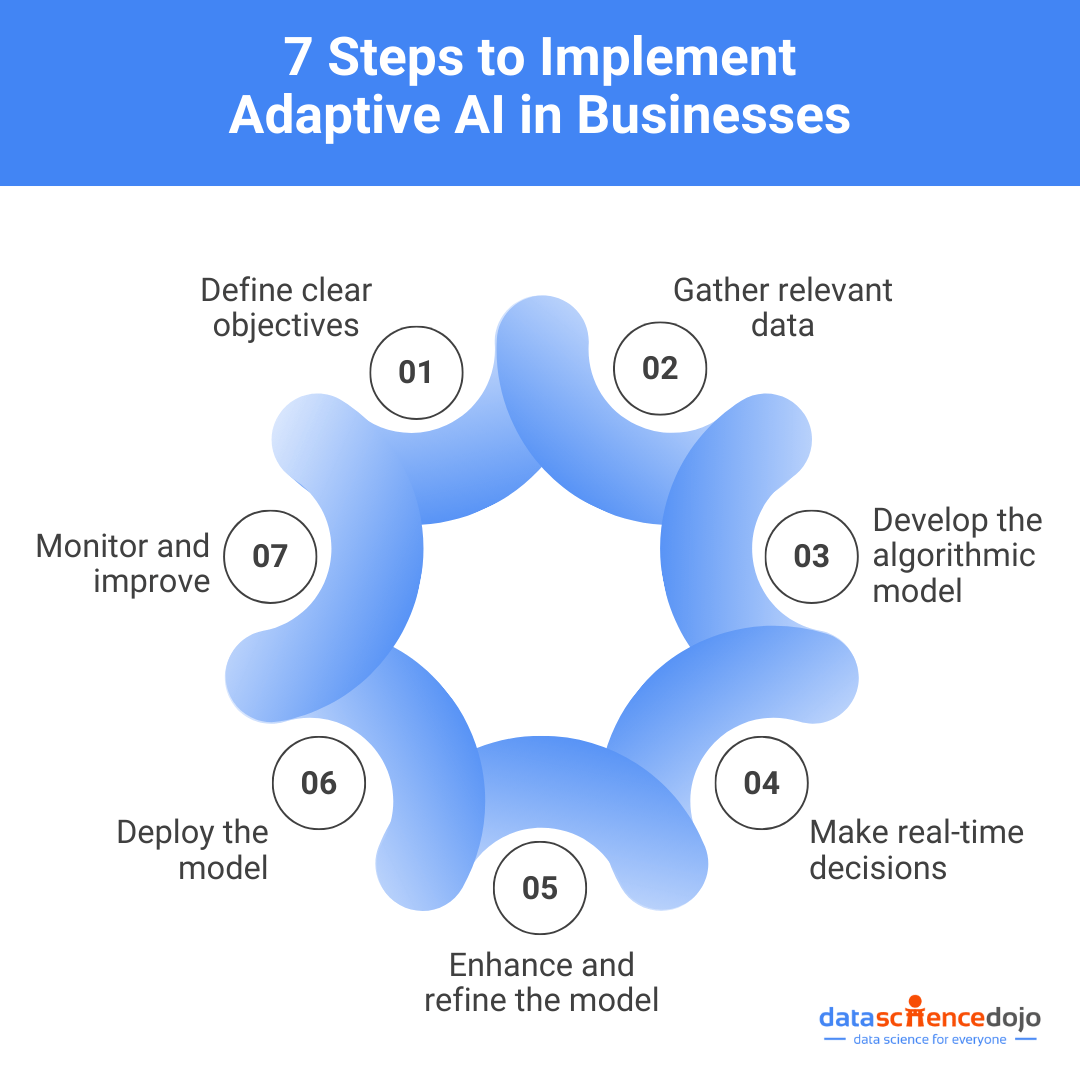
Here is a guide highlighting the key steps to ensure effective implementation.
- Define Clear Objectives:
- Start by clearly outlining the goals of your adaptive AI system. Specify the desired outcomes, such as image or text categorization, user behavior predictions, or market analysis.
- Use measurable metrics like accuracy and precision for performance evaluation. Understand the target audience so that the system can be tailored accordingly.
- Gather Relevant Data:
- Build a strong foundation by collecting data that aligns with your objectives. Ensure the data is diverse, up-to-date, and securely stored.
- Regularly update the data to maintain its relevance and utility for model development.
- Develop the Algorithmic Model:
- Transform the collected data into actionable insights. Choose the appropriate machine learning algorithms based on the problem at hand.
- Preprocess the data through normalization and handling missing values. Optimize hyperparameters for efficient model performance and benchmark the model against a separate validation dataset.
- Make Real-Time Decisions:
- Leverage the potential of adaptive AI by enabling real-time decision-making. Integrate data from various sources, preprocess it on the fly, and use predictive analytics to make immediate decisions.
- Implement a feedback loop for continuous system refinement.
- Enhance and Refine the Model:
- Even after deployment, continuously update and adjust the model to adapt to changing conditions and user needs. Retune hyperparameters, perform feature engineering, and retrain the model with fresh data to maintain effectiveness.
- Deploy the Model:
- Transition the model from a testing environment to real-world use. Convert the codebase to machine-friendly formats, provision necessary infrastructure, and manage the lifecycle with regular updates.
- Monitor and Improve:
- Establish ongoing monitoring mechanisms to ensure the system’s longevity and effectiveness. Monitor performance, periodically update data, reiterate the model based on evolving conditions, and augment components for continuous improvement.
Best Practices for Adaptive AI Deployment
When implementing adaptive AI and following the above 7-step process for its deployment, it is crucial to adopt the best possible practices. Each factor allows an optimized use of the AI system.
It is important to establish a strong foundation based on high-quality data. Moreover, you must implement data governance frameworks to ensure accuracy and compliance with regulations. This builds trust and lays the groundwork for ethical AI.
You must continuously monitor your AI’s performance. Use sophisticated tools to identify and address accuracy issues promptly. You must also create feedback loops that incorporate user experiences into the system. This continuous learning process keeps your AI sharp and evolving.
What are the Real-World Use Cases of Adaptive AI?
Adaptive AI has proven to be a transformative technology across various industries. Its ability to learn, adapt, and improve autonomously makes it particularly valuable in dynamic environments.
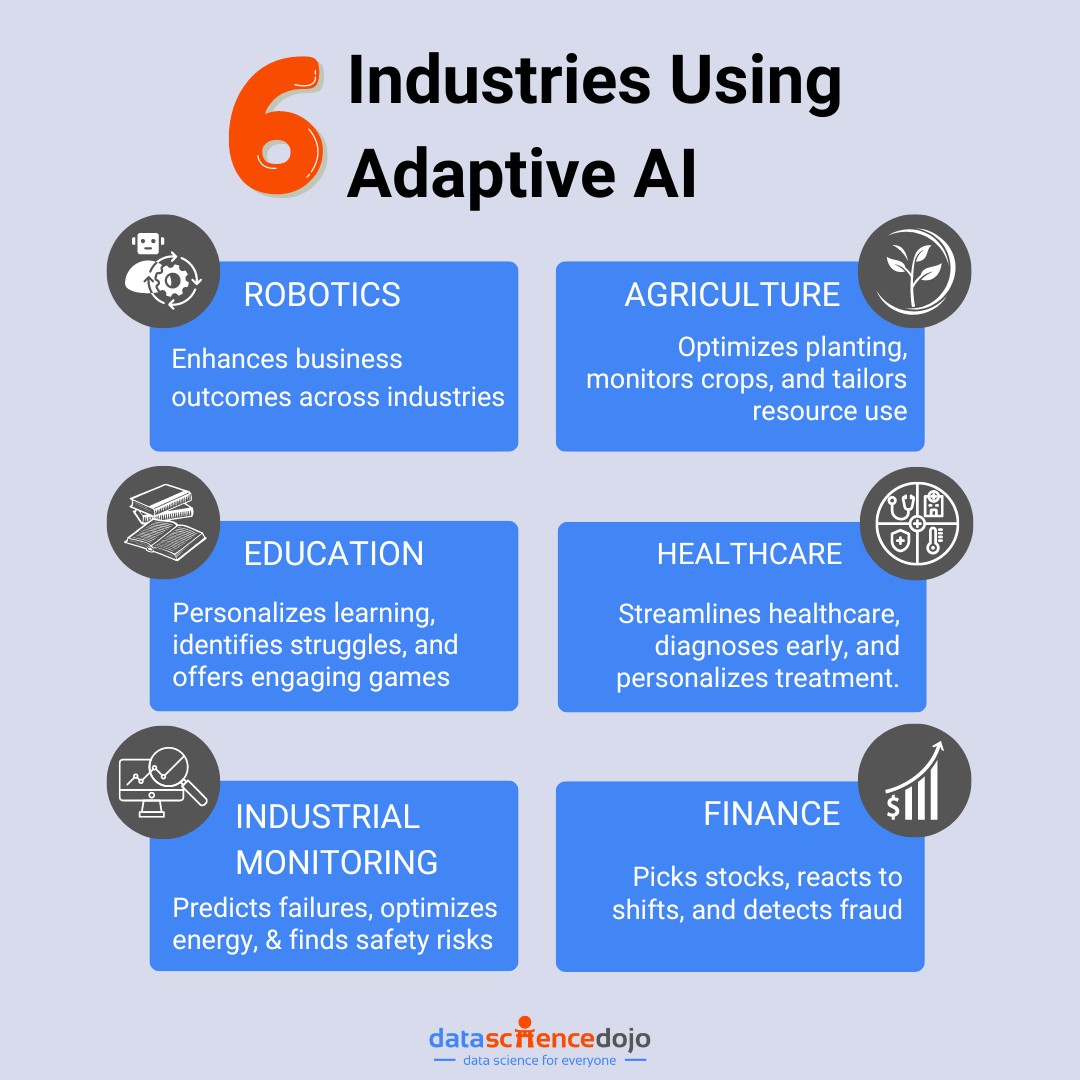
Let’s take a look at some of its practical applications and use cases across different industries:
Robotics
Adaptive AI has transformed the world of robotics in multiple ways, empowering machines to enhance user experience and business operations across different industries.
For instance, the robots functioning with this advanced AI system can analyze production data, adjust movements in real-time, predict maintenance needs, and maximize output. It enables them to optimize factory floor operations. Similarly, they improve the navigation capability of autonomous vehicles in dynamic environments.
Its application is seen in Brain Corp’s technology that empowers AI robots to navigate unstructured environments, featuring capabilities like mapping, routing, surface anomaly detection, and object avoidance. EMMA, a robot developed by Brain Corp, was tested in Walmart stores for after-hour floor cleaning.
Read more about 8 Industries Undergoing Robotics Revolution
Agriculture
Particularly within the agricultural world, adaptive AI offers the ability to effectively analyze weather patterns, soil data, and historical trends to suggest precise planting and harvesting recommendations. The AI system also enables monitoring of crops for early signs of infestation or disease, triggering targeted interventions.
Moreover, the real-time analysis of characteristics like soil moisture and nutrient levels assists farmers in maintaining optimal water and fertilizer use. For instance, Blue River Technologies and FarmSense utilize adaptive AI to optimize herbicide and pesticide consumption, targeting sustainable and efficient farming practices.
Education
Adaptive AI emerges as a useful tool for learning where it can analyze student performance in real time to develop dynamic and personalized learning pathways. The AI system can also assist in identifying struggling students, allowing teachers to provide them with timely targeted support.
This advanced AI has also introduced engaging learning experiences like personalized game-based learning. Duolingo uses adaptive AI algorithms to personalize language learning, tracking users’ progress and adapting to their language level for an efficient learning process.
Explore 3 examples where AI is Empowering the Education Industry
Healthcare
Healthcare has widely benefitted from implementing AI. It has assisted doctors in developing efficient patient care, detecting diseases at an early stage, and creating personalized treatment plans. AI systems also enable the automation of administrative tasks like appointment scheduling and medical record analysis.
Nuance Communications’ PowerScribe One supports radiologists by interpreting medical images and creating reports, learning from user feedback to enhance efficiency and accuracy.
Industrial Monitoring
In this field, these advanced AI systems are used to analyze sensor data and historical trends to predict equipment failures, enabling preventative maintenance. It also assists in optimizing energy consumption and identifying safety hazards.
Siemens uses AI technology to predict equipment wear and failures, allowing proactive interventions and minimizing downtime.
Finance
Adaptive AI is a useful tool for investment and trading by sorting relevant data sets and reacting accurately to market shifts and unexpected developments. It also assists in fraud detection by learning customer patterns, identifying anomalies, and alerting institutions to potential fraud.
Equifax employs AI-powered deep learning to evaluate customer risk, analyzing financial decisions over 24 months to approve additional loans without further losses.
Learn more about the Role of AI in Finance
Hence, by leveraging adaptive AI, various industries can optimize operations, enhance efficiency, and provide personalized experiences, ultimately driving growth and innovation.
What is the Future of Adaptive AI?
Gartner predicted a 25% competitive edge for businesses through the implementation of adaptive AI by 2026. This growth is driven by the technology’s ability to continuously learn and adapt, making it invaluable across various industries.
By providing personalized experiences, optimizing operations, and improving decision-making processes, adaptive AI helps businesses stay competitive and meet the evolving demands of their markets. This advanced AI system is poised to revolutionize industries by enabling real-time learning and adaptation.
Explore the roadmap of Llama Index to creating personalized Q&A chatbots
However, it is crucial to address ethical considerations, such as bias and fairness, to ensure the responsible development and implementation of these technologies. Embracing adaptive AI responsibly will not only drive innovation and efficiency but also create a more sustainable and prosperous future.



